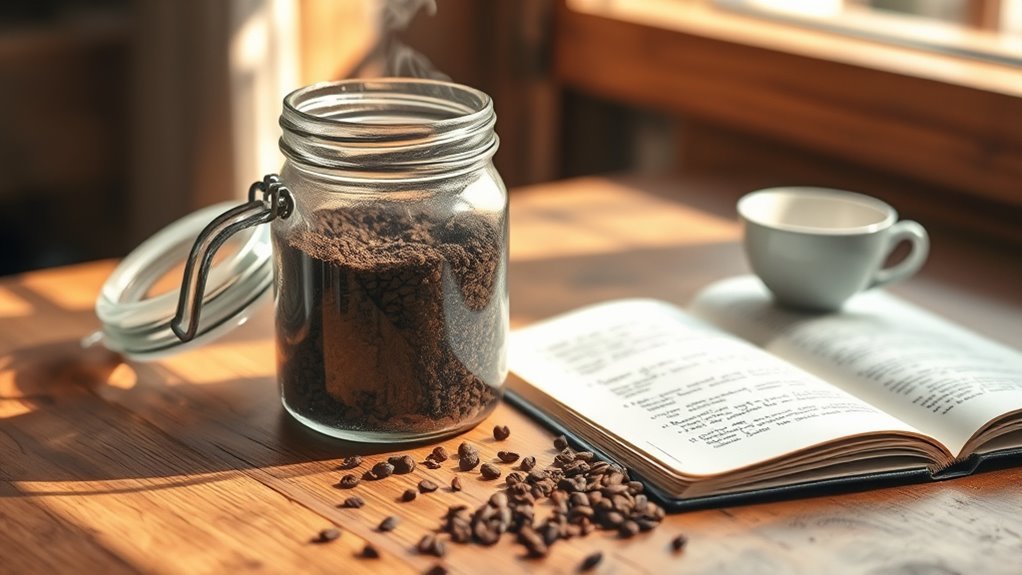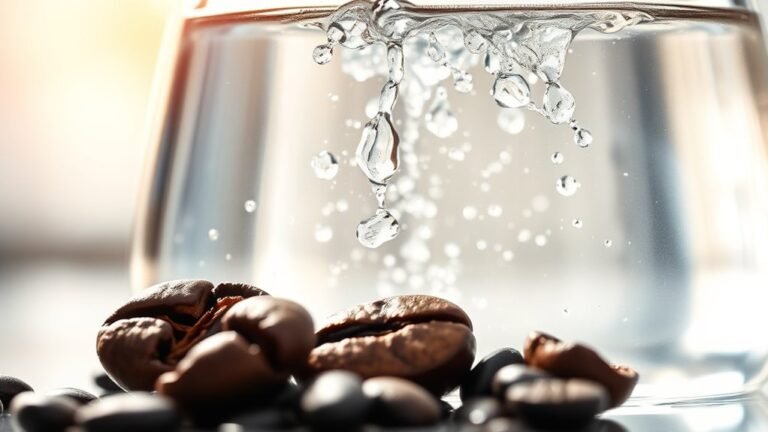How Many Times Can You Use the Same Coffee Grounds
You can typically reuse coffee grounds for one to three brews. However, keep in mind that the flavor diminishes with each extraction. The first brew offers the richest taste, while subsequent brews become milder and less satisfying. Factors like grind size, brewing method, and water temperature play a role in how effectively you can reuse grounds. If you’re curious about maximizing flavor and exploring creative uses for spent grounds, there’s more to discover on this topic.
Understanding Coffee Extraction
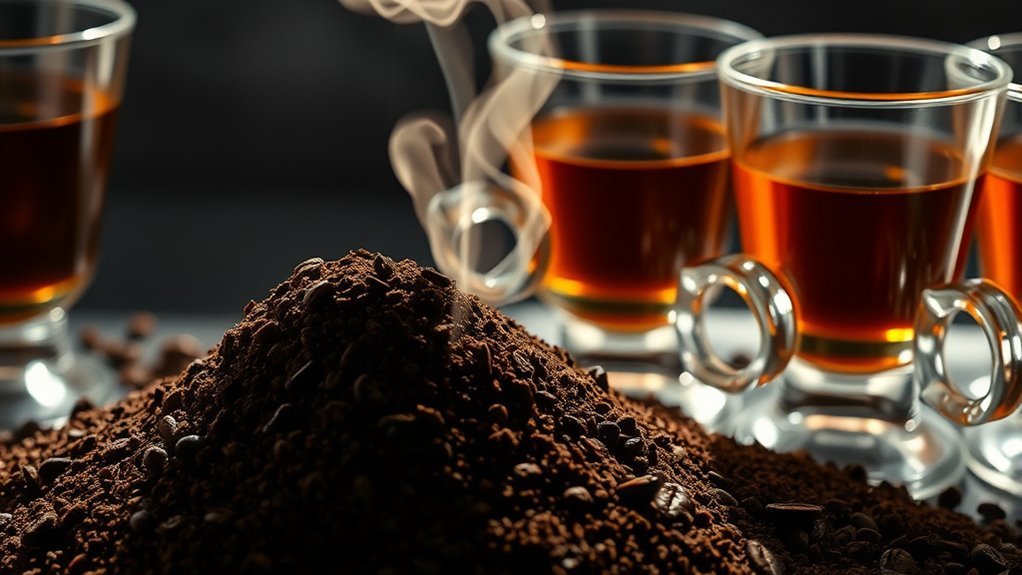
When you brew coffee, you’re fundamentally extracting flavors and compounds from the coffee grounds, and this process is crucial for understanding how many times you can reuse them. Coffee extraction involves dissolving various flavor compounds—acids, sugars, oils—from the grounds into your brew. The efficiency of this extraction depends on factors like water temperature, brewing time, and grind size. As you extract, the concentration of these compounds decreases, resulting in a less flavorful second or third brew. After the initial extraction, many of the desirable compounds are depleted, leading to a significant drop in taste quality. To maintain a satisfying coffee experience, it’s important to contemplate how many times those grounds can effectively yield flavor before they become exhausted.
Factors Affecting Reusability of Coffee Grounds
Although many coffee enthusiasts might be tempted to reuse their grounds, several factors considerably influence how many times this can be done effectively. One key factor is the brewing temperature; higher temperatures tend to extract more flavors and oils, leaving fewer desirable compounds in the grounds for subsequent brews. If you brew at lower temperatures, you might find the grounds can be reused a bit more, but the flavor profile may not be as rich. Additionally, grind size plays an essential role. Finer grounds extract quicker, leading to a diminished flavor faster than coarser grounds. By understanding these factors, you can make informed decisions about how many times you can reuse your coffee grounds while still enjoying a satisfying cup.
Brewing Methods and Their Impact
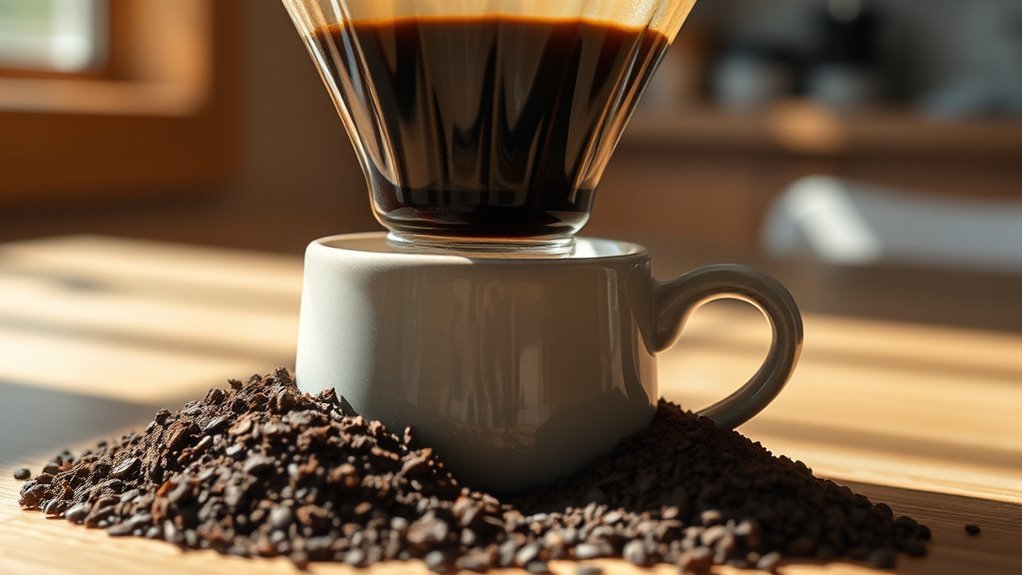
While various brewing methods can affect the flavor and strength of your coffee, they also play a significant role in determining how many times you can reuse your grounds. Different brewing techniques extract flavors differently, which influences reusability. Here are some key factors to evaluate:
- Brewing Time: Longer extraction generally yields less reusable grounds.
- Water Temperature: Higher temperatures can extract oils quickly, limiting reuse.
- Grind Size: Finer grinds can lead to over-extraction, impacting flavor profiles and reusability.
- Brewing Method: Methods like French press may allow more reuses than drip coffee.
- Personal Preference: Your taste buds ultimately decide how many times you can enjoy those grounds.
Understanding these factors helps you maximize your coffee’s potential.
Types of Coffee Beans and Their Potency
When considering coffee beans, it’s crucial to understand the differences between Arabica and Robusta varieties. Arabica beans tend to have a sweeter, more complex flavor profile, while Robusta beans are stronger and more bitter, often packing a higher caffeine punch. Additionally, the roast level can greatly impact the overall flavor and potency of the coffee, influencing your brewing choices.
Arabica vs. Robusta Beans
Understanding the differences between Arabica and Robusta beans is essential for any coffee enthusiast aiming to enhance their brewing experience. Each type has unique characteristics that influence flavor and potency.
- Arabica flavors are often described as smooth, sweet, and complex.
- Robusta strength provides a bold, earthy taste with higher caffeine content.
- Arabica beans grow at higher altitudes, while Robusta thrives in lower elevations.
- Arabica has a more delicate structure, making it less resistant to pests.
- Robusta beans are generally less expensive due to their higher yield.
Roast Levels Impact Flavor
Roast levels greatly influence the flavor profile of coffee, impacting how you experience each cup. The roast intensity can range from light to dark, each bringing out unique characteristics in the beans. Light roasts preserve the bean’s original flavors, highlighting fruity or floral notes. As you move to medium roasts, the flavor profile becomes more balanced, showcasing a blend of acidity and sweetness. Dark roasts, on the other hand, often introduce a more robust, bitter taste, masking some of the original flavors. Knowing the roast intensity helps you choose a brew that aligns with your personal preference. By understanding these nuances, you can elevate your coffee experience and enjoy a cup that truly resonates with your palate.
The Science of Flavor in Reused Grounds
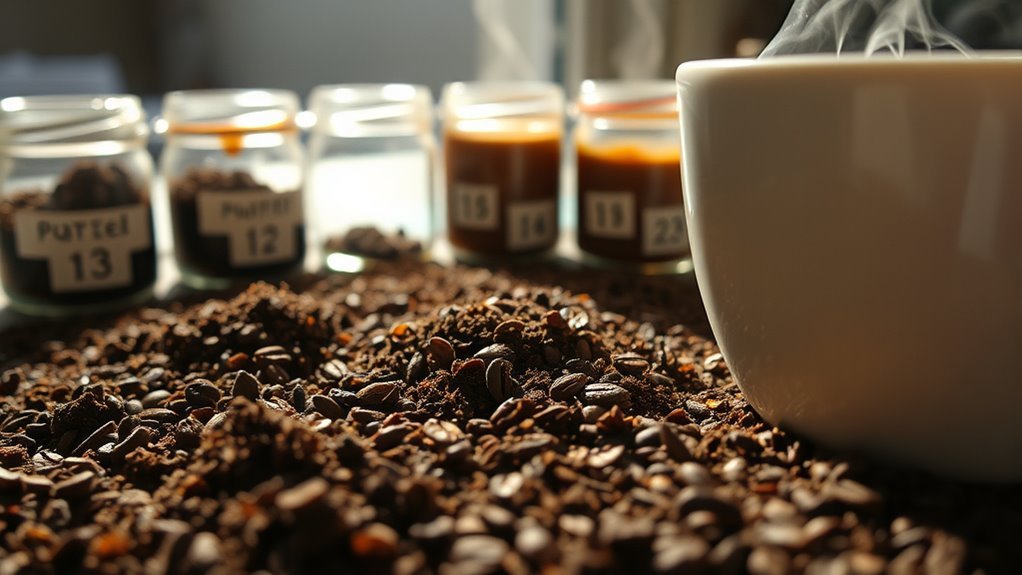
Although you may think that reusing coffee grounds always leads to diminished flavor, the science behind extraction reveals a more nuanced reality. When you brew coffee, various flavor compounds are released, but not all of them are extracted in one go. Here’s what you should know about the extraction efficiency of reused grounds:
- Some flavor compounds remain intact after the first brew.
- The second extraction can yield different notes and subtle flavors.
- Over-extraction can lead to bitterness, but careful reuse may enhance the profile.
- Brewing methods impact how compounds are released.
- Water temperature and time play essential roles in flavor extraction.
Understanding these factors can help you appreciate the potential in your second or even third cup!
Tips for Maximizing Flavor From Used Grounds
While you might think that used coffee grounds are only good for composting, there are several strategies you can employ to extract the most flavor from them. First, consider the timing of your brew; using your grounds within a day of brewing helps maintain flavor enhancement. Store used grounds in an airtight container to prevent oxidation and moisture absorption, which can diminish their taste. Additionally, try mixing used grounds with fresh coffee for a balanced brew, as this can amplify flavors. You can also repurpose them in cold brew, allowing for a different extraction method that can yield a unique taste. Finally, always experiment with grind size and brewing times to find what suits your palate best.
How Many Times Can You Brew With the Same Grounds?
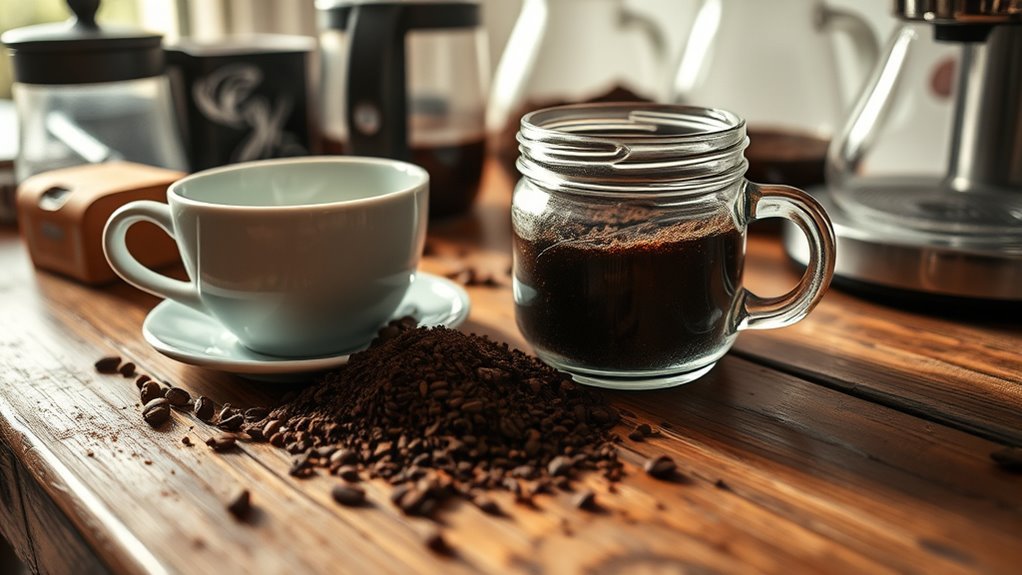
After exploring ways to maximize flavor from used coffee grounds, it’s important to reflect on how many times you can actually brew with them. Generally, you can reuse coffee grounds for about one to three brews, depending on the type of coffee and your brewing method. Here are some factors to take into account regarding brewing limits:
Understanding how many times you can brew with used coffee grounds is key to maximizing flavor and enjoyment.
- Type of Coffee: Darker roasts tend to yield less flavor after each use.
- Brewing Method: French press or pour-over methods allow for more flavor extraction compared to drip machines.
- Time Elapsed: Freshness diminishes quickly; use reused coffee promptly.
- Water Temperature: Hotter water extracts flavors more efficiently.
- Personal Preference: Some enjoy lighter brews, while others prefer a bolder taste.
Understanding these factors helps you maximize your coffee experience!
Creative Uses for Spent Coffee Grounds
Spent coffee grounds can serve multiple purposes beyond your morning brew. You can use them as a natural fertilizer to enrich your garden or as an effective odor neutralizer in your home. Exploring these creative applications not only reduces waste but also enhances your living environment.
Natural Fertilizer for Plants
If you’re looking for an eco-friendly way to nourish your plants, using coffee grounds as a natural fertilizer can be an excellent choice. These grounds are rich in nitrogen, promoting healthy growth and aiding nutrient release in your soil. When applied correctly, they can enhance your garden’s liveliness. Here are five creative ways to use coffee grounds:
- Mix into compost for improved nutrient balance.
- Sprinkle around plants to deter pests.
- Use in potting soil to boost drainage and aeration.
- Create a coffee ground tea for a liquid fertilizer.
- Incorporate into the garden bed to enrich the soil.
Odor Neutralizer for Spaces
While many people enjoy the rich aroma of freshly brewed coffee, it can sometimes leave behind unwanted odors in your home. Luckily, spent coffee grounds serve as an effective odor neutralizer. Their natural properties offer excellent odor absorption, making them invaluable in various spaces. Simply place a bowl of dried coffee grounds in your fridge or freezer to combat lingering smells. You can also sprinkle them in your trash can or use them in your car to eliminate unwanted odors. For an added touch, consider placing small sachets of grounds in closets or shoes to absorb moisture and odors. Embrace the coffee scent without the unwanted aftermath, and you’ll experience a fresher, more inviting environment.
Personal Taste Preferences and Reusing Coffee Grounds
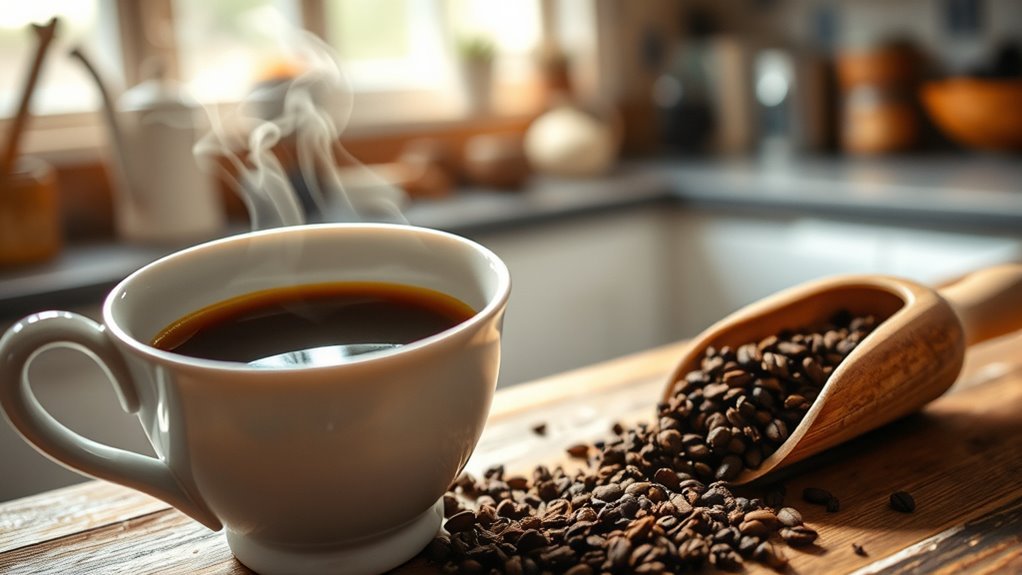
Although reusing coffee grounds can be economical and environmentally friendly, personal taste preferences play a significant role in determining how many times you might choose to brew with them. The flavor intensity diminishes with each reuse, so your individual palate will guide your choices. Here are some factors to evaluate:
Reusing coffee grounds can save money and reduce waste, but your taste preferences will ultimately guide how often you brew with them.
- Coffee type: Different beans have varying flavor profiles.
- Brew method: French press vs. drip can alter taste.
- Water temperature: Too hot can extract bitterness.
- Brewing time: Longer steeping may lead to over-extraction.
- Personal preference: Some enjoy a robust cup, while others prefer subtler flavors.
Ultimately, it’s about finding the balance between economy and the quality you desire in your cup.
Frequently Asked Questions
Can I Use Used Coffee Grounds for Baking?
Absolutely, you can use used coffee grounds for baking! They not only add a unique coffee flavor to your treats but also provide additional baking benefits, like enhancing moisture and texture. When incorporated into recipes like brownies or cakes, they can deepen the taste without overwhelming it. Plus, you’re reducing waste, which aligns perfectly with a sustainable lifestyle. So, don’t hesitate—get creative and experiment with those grounds in your baked goods!
Are Reused Coffee Grounds Safe to Consume?
Reusing coffee grounds can be safe for consumption, but it’s crucial to reflect on both the health benefits and flavor profile. While reused grounds may retain some antioxidants, their potency decreases with each use, affecting taste. If you’re mindful of potential mold growth or contamination, you can enjoy them in moderation. However, if you seek a robust flavor experience, fresh grounds might be the better choice for your daily brew.
How Should I Store Used Coffee Grounds?
To store used coffee grounds effectively, you’ll want to use airtight storage containers that minimize exposure to air. This helps in maintaining freshness and prevents the growth of mold. Additionally, pay attention to moisture control; keeping the grounds dry is essential to avoid spoilage. You might consider storing them in a cool, dark place, as light and heat can further degrade their quality. Proper storage allows you to maximize their potential uses.
Do Different Brewing Methods Affect Coffee Ground Reuse?
Different brewing methods can greatly impact coffee ground reuse. Curiously, studies show that using a French press can yield about 30% more extraction than drip brewing. This means the flavor intensity varies with each method. For example, while you might reuse grounds from a pour-over once, French press grounds could provide decent flavor even on a second brew. Understanding these nuances allows you to maximize your coffee experience while reducing waste. Enjoy experimenting!
Can I Mix Used Coffee Grounds From Different Brews?
Mixing used coffee grounds from different brews can impact your coffee flavor and brewing consistency. Each brew extracts unique compounds, so combining them might lead to a muddled taste profile. While experimentation can be fun, it’s essential to take into account that the flavors may not meld well. If you’re seeking a specific flavor, sticking to one type of used grounds might yield a more predictable and enjoyable experience in your cup.
